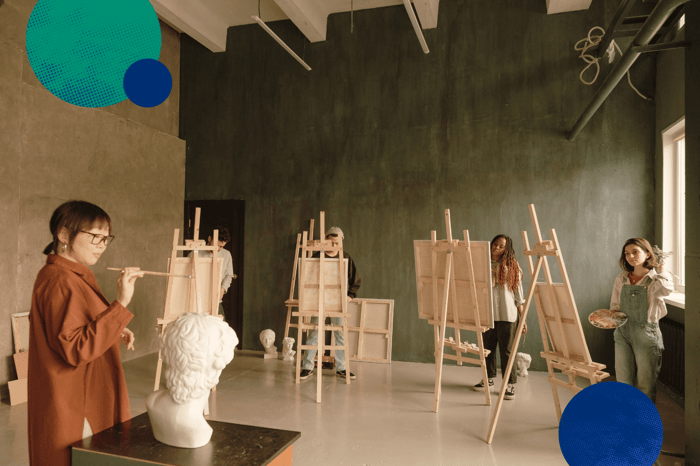StraighterLine has added to its offerings of 70+ online courses, Art Appreciation (also called Art 101), a new 3-credit course that fulfills an arts and humanities gen ed. This Art Appreciation college class equips you with the vocabulary to understand and discuss the visual arts, while introducing you to various mediums. Art helps create understanding of the world around us. It is an essential part of cultures across the globe because it allows us to be open to new ideas and experiences. In this Art Appreciation class online, you will learn themes of art, principles of design, types of two-dimensional and three-dimensional media, and be taken on a tour of art through the ages. You will learn the different eras of art, how culture is affected by and affects art, and how to use elements of a piece of work to identify its time period or artist. Plus, you can easily review the Art Appreciation class syllabus for a deeper look at the topics covered.
Why is Art Appreciation Important?
Art Appreciation is a fundamental skill that enhances our understanding of the world around us, our history, and ourselves. It goes far beyond simply admiring beautiful paintings or sculptures; it's about developing a deeper comprehension of human expression across time and cultures. By learning to appreciate art, we open ourselves to new perspectives, sharpen our critical thinking skills, and cultivate empathy for diverse experiences. Whether you're a student, a professional, or simply someone interested in enriching your life, understanding the importance of Art Appreciation can profoundly impact how you perceive and interact with the world. Let's explore the multifaceted significance of art appreciation and how it contributes to our personal growth and societal understanding.
Historical Perspective and Cultural Insight Through Art Appreciation
Art Appreciation provides a valuable historical perspective into different cultures and societies. By analyzing artwork, you gain insights not only into the specific piece but also the historical context from which it emerged. Artists often reflect societal issues in their work, allowing us to compare past and present societies.
Developing Critical Analysis Skills in Art Appreciation
Art Appreciation fosters critical thinking skills. It encourages individuals to look beyond the surface, analyzing design elements, artistic techniques, and mastery of craft. This process stimulates thought and promotes a deeper understanding of the artist's intent and message.
Broadening Mindsets and Encouraging Diverse Perspectives
Studying Art Appreciation can broaden our mindsets, both in relation to the artist's world and to the diverse viewpoints of other students. The subjective nature of art naturally encourages discussion about varying interpretations, requiring listeners to consider different perspectives.
Emotional Engagement and Personal Connection in Art Appreciation
Art is meant to stimulate thought and emotion, allowing viewers to draw from their personal experiences when interpreting a piece. This emotional engagement is a crucial aspect of Art Appreciation, as it fosters a deeper connection between the viewer and the artwork.
Fostering Open-Mindedness and Appreciation for Individuality
Art Appreciation teaches students that there can be multiple solutions to a problem, promoting open-mindedness. It also helps develop an appreciation for individual uniqueness, as each person's interpretation of art is influenced by their personal experiences and perspectives.
What Do You Learn in an Art Appreciation Course?
It is difficult to understand art without understanding the culture in which it was created. So with this important concept in mind, Art Appreciation, as a college course, centers on the ability to view art throughout history, focusing on the cultures and the people, and how art developed in the specific periods. “The history of the world is similarly the history of art, continually intertwined,” explains Deborah Gustlin, professor of fine arts at Gavilan College and art history at Evergreen Valley College. “For millions of years, as humans roamed the earth, evolution and environment shaped many different cultures depending on location, weather, natural resources, and food. These cultures formed the foundation of all art today. Art Appreciation analyzes art using the methods and materials, allowing people to make connections to the context of art and the interactions of societies.”
In this Art Appreciation course online:
- Receive an introduction to all visual art mediums
- Gain the knowledge to understand and analyze art
- Acquire the ability to discuss and write about art
- Learn to identify the movements from ancient cultures through contemporary art
In addition to the knowledge you will gain, the study of Art Appreciation develops several skills that are in demand by every employer across industries.
Art Appreciation as a course, “naturally develops critical and innovative thinking skills. [Studying] art also teaches many important qualities such as listening, observing, and responding to multiple perspectives,” note Kristin Gargaro and Emily Jilg, art teachers for South Lyon Community Schools. Gargaro and Jilg further explain how talking about art provides a forum for developing literacy and communication skills. When students engage in conversations about art they "develop visual thinking skills where they are able to observe closely, describe what they see in detail, and also provide evidence for their observations.”
About StraighterLine’s Art Appreciation Course Online
StraighterLine’s incredibly robust Art Appreciation course syllabus covers discussion and analysis of the following topics:
- Living with Art
- What is Art?
- Themes of Art
- The Visual Elements
- Principles of Design
- Drawing
- Painting
- Prints
- Camera and Computer Arts
- Graphic Design
- Sculpture and Installation
- Arts of Ritual and Daily Life
- Architecture
You will also dive into the following periods of art history:
- Ancient Mediterranean Worlds
- Christianity and the Formation of Europe
- The Renaissance
- The 17th and 18th Centuries
- Arts of Islam and of Africa
- Arts of Asia: India, China, and Japan
- Arts of the Pacific and the Americas
- The Modern World: 1800-1945
- From Modern to Postmodern
- Contemporary Art Around the World
Upon completion of StraighterLine’s Art Appreciation course online, you will be able to:
- Understand the value of art, its many uses, and its history
- Define the key vocabulary of art such as value, form, design, space, proportion, scale, balance, unity, and variety
- Classify different two-dimensional, three-dimensional, and abstract mediums like installations
- Analyze art through the lens of history, its effects on culture, and culture's effects on art
- Construct a formal analysis of a piece of art
Take Art Appreciation with StraighterLine
Interested in learning more about StraighterLine’s Art Appreciation course online? Download the Art Appreciation course syllabus and register today to earn 3 easily transferable college credits!













